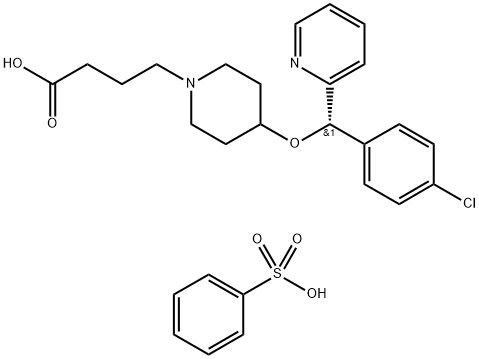Bepotastine Besilate , 98% , 190786-44-8
CAS NO.:190786-44-8
Empirical Formula: C27H31ClN2O6S
Molecular Weight: 547.07
MDL number: MFCD01938491
EINECS: 1806241-263-5
| Pack Size | Price | Stock | Quantity |
| 10MG | RMB72.00 | In Stock |
|
| 50MG | RMB149.60 | In Stock |
|
| 100MG | RMB255.20 | In Stock |
|
| 250MG | RMB411.20 | In Stock |
|
| 1G | RMB980.80 | In Stock |
|
| others | Enquire |
PRODUCT Properties
| Melting point: | 161-163° |
| alpha | D20 +6.0° (c = 5 in methanol) |
| storage temp. | Inert atmosphere,Room Temperature |
| solubility | DMSO (Slightly, Heated), Methanol (Slightly, Heated) |
| form | Solid |
| color | White to Light Beige |
| optical activity | [α]/D 4.5 to 6.5°, c =1 in methanol |
| Stability: | Hygroscopic |
Description and Uses
Betotastine was introduced in Japan for the treatment of allergic rhinitis. This structurally-related derivative of chlorpheniramine and ebastine is prepared by condensation of optically-resolved 4-[1-(4-chlorophenyl)-1-(2-pyridyl)-methoxy]piperidine with ethyl 4-bromobutyrate followed by ester hydrolysis. Betotastine is the seventh marketed non-sedating histamine H1 antagonist. Its very low sedative side effect is due to very poor penetration in the central nervous system. Besides its potent and long-acting activity in models of allergic rhinitis, betotastine was also shown to act as a PAF antagonist and inhibit LTD4 in tracheal smooth muscle and ileum, IL-5 production by human peripheral blood mononuclear cells as well as eosinophil infiltration in the airway and peripheral blood. As a consequence, it is currently being developed against other allergic and respiratory disorders.
Bepotastine is a histamine H1 receptor anatagonist. Bepotastine suppresses some allergic inflammatory processes such as allergic rhinitis, chronic urticaria or pruritus associated with skin conditions (eczema/dermatitis, prurigo or pruritus cutaneus).
Safety
| Symbol(GHS) |  GHS07 |
| Signal word | Warning |
| Hazard statements | H302-H315-H319-H335 |
| Precautionary statements | P261-P305+P351+P338 |


![Ethyl 4-(1-methyl-5-nitro-1H-benzo[d]imidazol-2-yl)butanoate](https://img.chemicalbook.com/CAS/GIF/3543-72-4.gif)
![Ethyl 4-(5-amino-1-methyl-1H-benzo[d]imidazol-2-yl)butanoate](https://img.chemicalbook.com/CAS/GIF/3543-73-5.gif)
![Ethyl 4-(5-(bis(2-hydroxyethyl)amino)-1-methyl-1H-benzo[d]imidazol-2-yl)butanoate](https://img.chemicalbook.com/CAS/GIF/3543-74-6.gif)
![(2AR,2''R,4S,5''R,6aR,6bS,8aS,8bR,9S,11aS,12aS,12bS)-2a,4-dihydroxy-5'',6a,8a,9-tetramethylicosahydrospiro[naphtho[2'',1'':4,5]indeno[2,1-b]furan-10,2''-pyran]-2(11aH)-one](https://img.chemicalbook.com/CAS/GIF/56786-63-1.gif)
